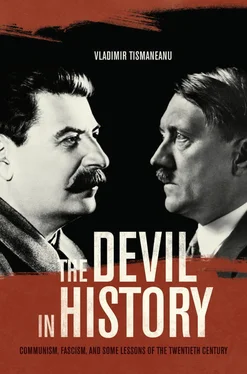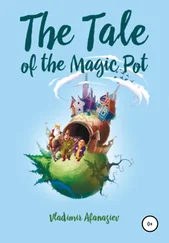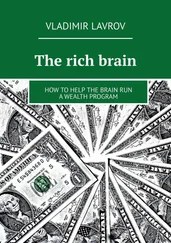In the same vein, Hitler saw the war with the Soviet Union and Western democracies as an ideological crusade meant to totally destroy the ideologically dehumanized enemy. 15Gellately quotes the recollections of one of Hitler’s secretaries: “We will win this war, because we fight for an idea, and not for Jewish capitalism, which drives the soldiers of our enemies. Only Russia is dangerous, because Russia fights with the same fanaticism as we do for its worldview. But the good will be the victor, there is nothing else for it.” 16
Bolshevism cannot be understood without admitting Lenin’s paramount role. Without Lenin, there would have been no Bolshevism. Stalin was indeed the beneficiary of a system that Lenin had imagined and developed. In the absence of the ideology developed by Lenin, these regimes would have remained traditional tyrannies. 17Indeed, as sociologist Daniel Chirot emphasized, we deal with two types of despotic regimes: tyrannies of corruption (the traditional ones) and tyrannies of certitude, based on ideological hubris. 18It was the ideological pretense, the conviction that he was fulfilling a grandiose historical mission, that made Lenin engage in his reckless attempt to radically transform society. In his footsteps, Stalin pursued the same all-transforming agenda: nature, science, and language all had to be subordinated to the sacrosanct goal. The same ideological ardor, impervious to doubt or self-questioning, motivated Hitler’s delusional visions of global race warfare. 19As Arthur Koestler demonstrated long ago, totalitarian movements disregard ethics and despise moral absolutes: “Since about the second half of the nineteenth century our ethical brakes have been more and more neglected until totalitarian dynamism made the engine run amok. We must apply the brake or we shall crash.” 20
In spite of its claim to transcend alienation and rehabilitate human dignity, Communism was morally sterilized, or, in the words of Steven Lukes, it suffered from moral blindness. 21Once it subordinated the notion of the good to the interests of the proletariat, Communism annulled the universality of moral norms. The same can be said about Fascism, with its exaltation of the primeval tribal virtues and total disregard for the common humanity of all human beings. Both assigned to the state its own morality, granting only to it the right to define the meaning and ultimate aim of human existence. The ideological state became the supreme and absolute value within the framework of an eschatological doctrine of revolution. The horrors that defined the past century were thus possible because of a “moral inversion”: “The state’s crimes [were] explicable not as crimes but as necessary precautions to prevent greater injustice.” 22Through the cult of absolute unity along the path to salvation by knowledge of history, both Communism and Fascism produced new and total social and political projects centered on purifying the body of the communities that fell prey to these ideological spells. The new men or women brought about by these movements left behind their “little ego, twitching with fear and rickets,” for they had surrendered what the proletarian writer Maxim Gorky called despairingly the “farce of individuality.” 23Or, as a former member of the German Communist Party once declared: “A man who fought alone could never win; men must stand together and fight together and make life better for all engaged in useful work. They must struggle with every means at their disposal, shying at no lawless deed as it would further the cause, giving no quarter until the revolution triumphed.” 24A strikingly similar statement can be found in Nazi chef propagandist Joseph Goebbels’s early novel, Michael: A German Destiny: “What makes up the modern German is not so much cleverness and intellect as the new spirit, the willingness to become one with the people, to devote oneself and sacrifice oneself to it unstintingly.” 25Indeed, the times called for the dissolution of the individual into a heroic collective built on the rubble of a modernity that was declared defunct. Either from the left or from the right, the horrors of the twentieth century came about once “modernist revitalization movements” (in the words of Roger Griffin) became full-fledged state programs of social engineering.
Stalin’s former henchman and close associate Vyacheslav Molotov’s unrepentant evaluation of the Great Terror exemplifies the new dynamic between power and morality: “Of course there were excesses, but all was permissible, to my mind, for the sake of the main objective—keeping state power!… Our mistakes, including the crude mistakes, were justified.” 26Once these political movements constructed their vision of modernity on the principle of a chosen, purified community crossing the desert of history from darkness into light, there could be only one solution for those who failed to meet their inclusionary criteria: excision. 27Unsurprisingly, the same Molotov explained the oppression of the families of those purged, executed, deported, or assassinated as prophylactic action: “They had to be isolated. Otherwise, they would have spread all kinds of complaints, and society would have been infected by a certain amount of demoralization.” 28Similarly, in 1926, Yemelyan Yaroslavsky, an official Bolshevik historian and Joseph Stalin’s confidant, justified the purges decided at the sixteenth party conference (April 1929) as a method of protecting “the cells of the party and soviet organism from ‘degeneration.’” 29
Such affliction-weary rhetoric about the body politic was hardly different from that employed by Himmler in his speech to SS leaders at Posen in October 1943. The Reichsführer-SS described Nazi policies as extermination of “a bacterium because we do not want in the end to be infected by the bacterium and die of it. I will not see so much as a small area of sepsis appear here or gain a hold. Wherever it may form, we will cauterize it.” 30To paraphrase Italian historian Gaetano Salvemini, both Fascism and Communism decided they had found the key to happiness, virtue, and infallibility, and were prepared to kill in applying it to specific societies.
THE ENIGMA OF TOTALITARIANISM
Herein lies the essence and mystery of the totalitarian experiences of the twentieth century: “The complete rejection of all barriers and all restraints that politics, civilization, morality, religion, natural feelings of compassion, and universal ideas of fraternity have constructed in order to moderate, repress, or sublimate the human potential for individual and collective violence.” 31The real similarities between the Communist and Fascist experiments (the crucial role of the party, the preeminence of ideology, the ubiquitous secret police, the fascination with technology, the frenzied cult of the “New Man,” the quasi-religious celebration of the charismatic leader) should not blur significant distinctions (one being the absence of Nazi show trials or intraparty permanent purges). Nevertheless, historian Eugen Weber judiciously remarked that “the distinction between fascism and communism is relative rather than absolute, dynamic rather than fundamental.” Under the circumstances, one cannot help but ask the same question as Weber: “Isn’t this fundamental similarity between totalitarian creeds and systems at least as important as their differences of view?” 32This book engages in a dialogue with the most influential contributions to these morally and politically urgent questions. The twentieth century was plagued by agonizing ideological polarizations whose effects continue to haunt our times.
I agree with political scientist Pierre Hassner that despite the differences between Stalinism and Nazism, their fundamental and defining common characteristic was their genocidal frenzy. Or, to use Sheila Fitzpatrick and Michael Geyer’s formulation, “The phenomenon of the gulag as a manifestation of Soviet state violence and the Holocaust as the central site of Nazi terror conveys the unmistakable message that the two regimes were bent on genocide [my italics].” 33On the one hand, both Stalinism and Nazism looked for “objective enemies” and operated with notions of collective, even genetic guilt. Obviously, the Bolshevik vision stigmatized political “sins,” whereas the Nazi Weltanschauung reified biological distinctions. In his enormously significant toast of November 7, 1937, on the occasion of the twentieth anniversary of the Bolshevik coup, as recorded by the Comintern leader Georgi Dimitrov and in his diary, a speech meant to be known only by the top party and People’s Commissariat for Internal Affairs (NKVD) elite, Stalin said, “Whoever attempts to destroy the unity of the socialist state, whoever seeks the separation of any of its parts or nationalities—that man is an enemy, a sworn enemy of the peoples of the USSR. And we will destroy each and every such enemy, even if he was an old Bolshevik; we will destroy all his kin, his family. We will mercilessly destroy anyone who, by his deeds or his thoughts,—yes, his thoughts—threatens the unity of the socialist state. To the complete destruction of all enemies, themselves and their kin! (Approving exclamations: To the great Stalin!)” 34
Читать дальше












